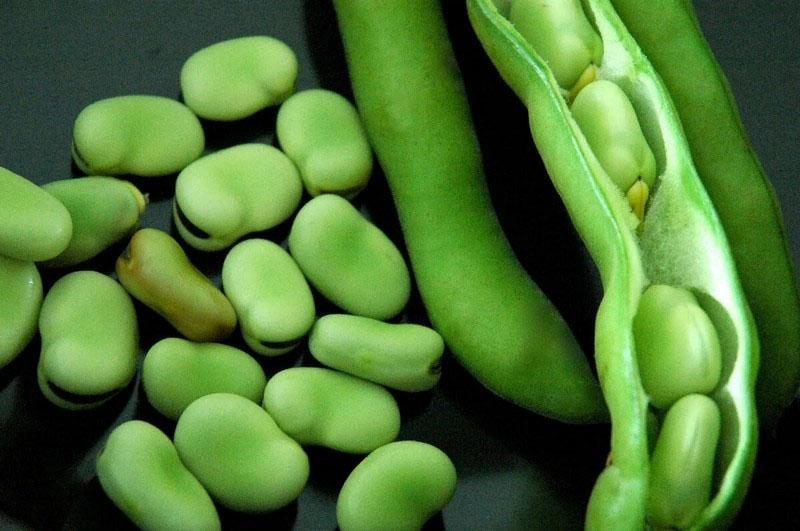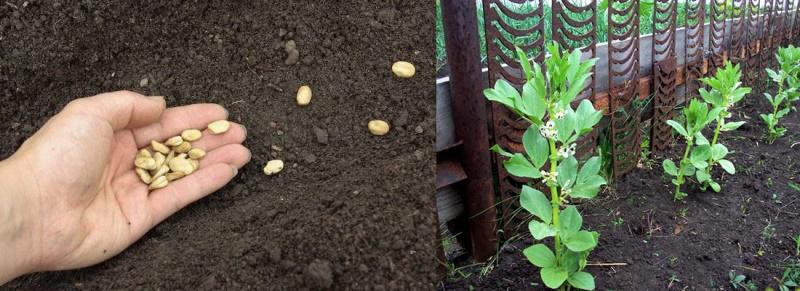Planting and caring for beans outdoors without problems
 Garden or horse beans are grown in many countries of the world, but most of all in India and China. Planting and caring for beans in the open field is not difficult and does not cause difficulties even for gardeners in the northern regions of Russia. The beans tolerate light frosts easily and can grow in a variety of soils.
Garden or horse beans are grown in many countries of the world, but most of all in India and China. Planting and caring for beans in the open field is not difficult and does not cause difficulties even for gardeners in the northern regions of Russia. The beans tolerate light frosts easily and can grow in a variety of soils.

Choosing a site for planting beans
 Beans grow best on loose loam with a slightly alkaline or neutral reaction. Even in soil with little nutrients, these undemanding plants will be able to produce decent yields if they have enough potassium. With its lack, add to the soil before planting wood ash or other organic matter.
Beans grow best on loose loam with a slightly alkaline or neutral reaction. Even in soil with little nutrients, these undemanding plants will be able to produce decent yields if they have enough potassium. With its lack, add to the soil before planting wood ash or other organic matter.
There are other conditions to consider when choosing a site for growing beans:
- the place should be open and bright, located on a small hill;
- the duration of its illumination by the sun - maximum;
- too wet soil in a cold lowland will not work;
- excess nitrogen in the soil negatively affects the development of plants.
When growing beans, you must strictly follow the rules of crop rotation.
They cannot be planted in the beds where soybeans, peas, lentils, beans and other plants belonging to the legume family. In the process of development, they actively produce nitrogen-containing substances, and the beans do not tolerate their excess poorly.
 With proper planting of beans and caring for them in the open field, you need to take into account the influence on their development of those crops that grew in this area earlier. The best precursors for vegetable beans are tomatoes, cucumbers, cabbage, or potatoes.
With proper planting of beans and caring for them in the open field, you need to take into account the influence on their development of those crops that grew in this area earlier. The best precursors for vegetable beans are tomatoes, cucumbers, cabbage, or potatoes.
But experienced gardeners do not advise planting potatoes and beans in one hole or next to it. Both crops require a lot of potassium to thrive. But due to the faster growth of the beans, the potatoes lack it. The root system of legumes "supplies" nitrogen to the soil, and the grown shoots shade the lagging potatoes, which, due to lack of lighting, begin to grow vigorously tops, and not tubers. The yield loss, in this case, can be significant. When beans are planted together with other crops, they are planted around the perimeter of the beds or the area with potatoes.
Planting and caring for beans outdoors without shelter
 Sowing beans begins in early spring, as soon as air temperatures exceed 3-4 ° C. They are quite cold-resistant and survive light frosts without problems.
Sowing beans begins in early spring, as soon as air temperatures exceed 3-4 ° C. They are quite cold-resistant and survive light frosts without problems.
However, the intensity of plant development still depends on the vagaries of the weather:
- even at 16–17 ° C, the beans do not stop growing;
- a temperature of 20–22 ° C is considered optimal for them.
When the temperature rises above 25 ° C, the flowers of the beans begin to fall off.
How to germinate beans for outdoor planting
 Bean seeds are stored for a long time, more than 5 years. They are sown in prepared in autumn and slightly dried out soil. If the ground is already dry, the planting hole or rows are watered.To help the beans sprout faster, they are soaked overnight. Floating seeds cannot be planted.
Bean seeds are stored for a long time, more than 5 years. They are sown in prepared in autumn and slightly dried out soil. If the ground is already dry, the planting hole or rows are watered.To help the beans sprout faster, they are soaked overnight. Floating seeds cannot be planted.
Since traders process the seeds for sale, they don't need anything else.
And for collected at home, processing is required. It is carried out as follows: 30 g of edible salt is stirred in one liter of warm water and beans are placed in it for 10 minutes.
The timing and scheme of planting beans
 In different regions, the timing of planting legumes in open ground does not coincide. In the conditions of central Russia with a moderate continental climate, as a rule, the period begins in late April or early May. But if you plant them in open ground every month, then the harvest (in technical ripeness) can be harvested in most parts of the country until mid-autumn.
In different regions, the timing of planting legumes in open ground does not coincide. In the conditions of central Russia with a moderate continental climate, as a rule, the period begins in late April or early May. But if you plant them in open ground every month, then the harvest (in technical ripeness) can be harvested in most parts of the country until mid-autumn.
Planting early in spring has several benefits:
- plants are less affected by aphids;
- higher productivity;
- the seeds are large, they have more proteins, starches, lipids;
- the possibility of obtaining several harvests.

It is customary to plant seeds in several ways, which depend on the chosen agricultural technology for growing beans:
- Tape method. Tapes are made, observing a distance of 70 cm. The row spacing should be at least half a meter. And the distance between the nests in one row is no more than 15 cm. No more than three seeds are placed in each of them.
- Two-line landing pattern. Bean seeds are planted on special beds in compliance with a certain seeding density, which for tall varieties is 20 seeds per 1 m², and for dwarf varieties - 28 seeds per 1 m².
- Square-nested method. Seeds are placed in 3 pieces in the corners of a 70 cm x 70 cm square.

Beans should be planted in manure-fertilized soil no earlier than a year or two.
Bean care

After applying complex mineral fertilizers to the soil, legumes do not lack nutrients, their development is much more active:
- When sowing in rows, for every 2 m, add 1 teaspoon of nitroammophoska.
- During the digging of the site before winter, bring nitrophosphate, 5-7 g / m².
A couple of weeks after the emergence of shoots, to increase the nutritional value of the soil, add (in the form of a solution) to 1 m²:
- superphosphate (25-30 g);
- ammonium nitrate (5-9 g);
- potassium chloride (5-10 g).
On peat soils, it is necessary to additionally apply micronutrient fertilizers containing copper.
When beans bloom and bear fruit, they need to provide the necessary soil moisture, since during a drought, fruits and flowers fall off. It is quite enough to water 2 times a week, 1 bucket of water per 1 m².
Reliable varieties of beans for planting
 Among the varieties of vegetable beans there are early, mid-early, mid-season and late. They are selected depending on the geographical location of the area, the characteristics of the soil on the site and, of course, based on personal preferences.
Among the varieties of vegetable beans there are early, mid-early, mid-season and late. They are selected depending on the geographical location of the area, the characteristics of the soil on the site and, of course, based on personal preferences.
Russian black - the oldest variety, early ripening. Differs in stable fruiting. Usually grown in the northern regions of the country. The stem height reaches 70 cm. Harvesting can be carried out within a month and a half after planting. Fruits are small, they usually contain no more than 3-4 grains. The fleshy valves do not have a parchment layer, which is why they can be preserved in technical ripeness or various dishes are prepared from them.
Velena is a medium early bean variety. You can harvest the first crop within 65 days after planting in the ground. And at the stage of seed ripening - after 85 days. Stems are weakly branched, grow up to 1 m, the yield reaches 0.8 kg / m².
Three times white - mid-season variety, from germination to milk-wax ripeness of fruits about 90 days. The height of an erect, medium-leafed plant is about 1.2 m. The beans themselves are green, the valves are thick. The seeds are large, white. The yield of the variety is up to 0.8 kg / m². The variety is resistant to the most common diseases. It is practically not damaged by weevils and pea weevils.
These varieties are suitable for growing beans in the country in the Moscow region and throughout the Non-Black Earth Region.They do not need to be carefully looked after. It is enough to loosen the soil after heavy rains, and water it in time during the dry period. In order for the beans to form pods faster, after the appearance of the ovaries, the tops of the plants are pinched.
When to plant beans in Siberia
 The continental and sharply continental climate of Siberia is rather harsh, even despite all the changes that have been taking place on the entire planet in recent years. Peas and beans in Central and Eastern Siberia should be planted in open ground in the second decade of May, when there is no longer any danger of recurrent frosts. It is better if the predecessors are pumpkin or nightshade - eggplants, tomatoes, peppers, potatoes.
The continental and sharply continental climate of Siberia is rather harsh, even despite all the changes that have been taking place on the entire planet in recent years. Peas and beans in Central and Eastern Siberia should be planted in open ground in the second decade of May, when there is no longer any danger of recurrent frosts. It is better if the predecessors are pumpkin or nightshade - eggplants, tomatoes, peppers, potatoes.
Planting and caring for beans in the open field is carried out everywhere. Dry seeds are usually planted. But in especially cold years, the seedling method is used - seedlings are grown in peat pots. The distance between the nests is at least 10 cm, the seeds are buried by 2.5 cm. Row spacing is left, about 20-25 cm.
The whims of the Siberian weather force many gardeners to protect the plantings from the destructive sharp cold snaps. Above the beds, temporary light shelters are built from non-woven materials, or the nests are covered with seeds with cut bottles and cans.